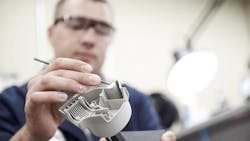Now that 3-D printing is safely beyond the hype phase and has become an established part of many companies’ product development and manufacturing processes, there has been a greater understanding of the technology’s technical and business advantages. With that, more users are benefitting from lighter and more durable parts, increased design freedom and on-demand part production.
But that’s just scratching the surface of 3-D printing’s potential.
There’s still room to maximize the technology across their entire value chain, from design and engineering to the production floor and beyond. In a hypercompetitive industry like manufacturing, it’s important to leverage all the tools at your disposal.
Here are six ways you can make the most of 3-D printing.
Manage Shorter Lead Times
While it can take months to build parts via traditional manufacturing, 3-D printing can build parts in just days or hours. There is no time lost developing a tool or waiting for a first shot off the mold. Design files are sent straight to the printer for fabrication, then post-processed as needed.
It can also expedite product development since any design tweaks don’t require added set-up costs for machining or tooling production, which can lead to delays. With 3-D printing, all it takes is a quick update to the design file, helping companies get to market quicker.
Design for Function
One of 3-D printing’s biggest benefits is its design freedom. Using traditional manufacturing methods, companies tend to design parts more for the manufacturing process rather than the part’s function, which means they could be left with a part not fully optimized for its intended use. With 3-D printing, there are no such compromises. Designers can maximize a part’s function through its design because 3-D printing allows them to incorporate challenging features directly with no added difficulty in the manufacturing process. Businesses still getting their feet wet with 3-D printing can get a fast win by using it to build manufacturing tooling and bridge production components.
Integrate into the Product Development Cycle
It’s well-established that 3-D printing works well with prototyping, but the technology has much more to offer. Beyond prototyping, 3-D printing provides solutions for applications like architectural modeling and production parts, making it a highly utilizable technology across the product development cycle. Companies that take full advantage of additive understand the extent of its production capabilities, including what applications the technology can serve for them.
Of course, this tip is dependent on what industry — or industries — companies operate in because they may not yet need to widen its scope. But for those with multiple needs, like prototyping and production parts, using additive could offer a major benefit.
Use More Than One Process, Material
A company that’s adept at 3-D printing will understand how to use numerous processes and materials and which are most beneficial for specific applications. They will experiment with metals and plastics. They will test various processes — direct metal laser sintering, fused deposition modeling and laser sintering, for example – and learn which ones make sense for which applications. Doing so expands companies’ 3-D printing knowledge and better positions them to reap the competitive advantages. Additionally, failure to experiment beyond what’s comfortable — or beyond what everybody else is doing — can leave companies stagnant.
Break Down the Manufacturing Silos
Two processes are sometimes better than one. Using 3-D printing in conjunction with traditional manufacturing allows users to reap the benefits of both. Companies can use 3-D printing to build jigs and fixtures, validate tools, and for bridge production, helping reduce production costs and lead times for large volume production jobs using traditional methods.
Find an Internal Champion
Those who realize 3-D printing’s full offerings tend to have an internal champion who can explain its technical and business benefits. That could mean helping incorporate 3-D printing into strategic initiatives or serving as the education point person. Having an internal champion is important in not only getting their companies to understand 3-D printing but to also determine how and where it can be implemented.
* * *
Don’t be concerned if you haven’t implemented all these recommendations. 3-D printing is an ever-evolving technology, and there’s still room to learn for even the most advanced users. Regardless of where you are, the best place to start with better integrating 3-D printing into their manufacturing processes is with education. Learning about the variety of technologies within additive manufacturing and the reasons to use them will lead to further insights for their business.
It’s also vital to for companies to examine their infrastructure. Are there skills or equipment gaps that must be filled in order to properly leverage in-house 3-D printing? Companies that don’t or won’t use the technology enough to make the in-house investment worth it can look to outsourcing to provide an effective way to still realize the technology’s benefits. 3-D printing service providers can lend a technical and experienced hand — or offer support for high-volume jobs that require more capacity.
Finally, you shouldn’t underestimate the importance of ‘selling’ the technology to both its engineers and its executives. It’s imperative that both parties understand how 3-D printing benefits them. An internal champion who can speak to both the business and technical value of the technology can be a point person for this.
Will that be you?
Kent Firestone is the COO at Stratasys Direct Manufacturing. Kent has over 25 years of experience in the additive manufacturing industry and Laser Sintering applications development.
About the Author
Kent Firestone
Kent Firestone is the COO at Stratasys Direct Manufacturing. Kent has over 25 years of experience in the additive manufacturing industry and Laser Sintering applications development.
